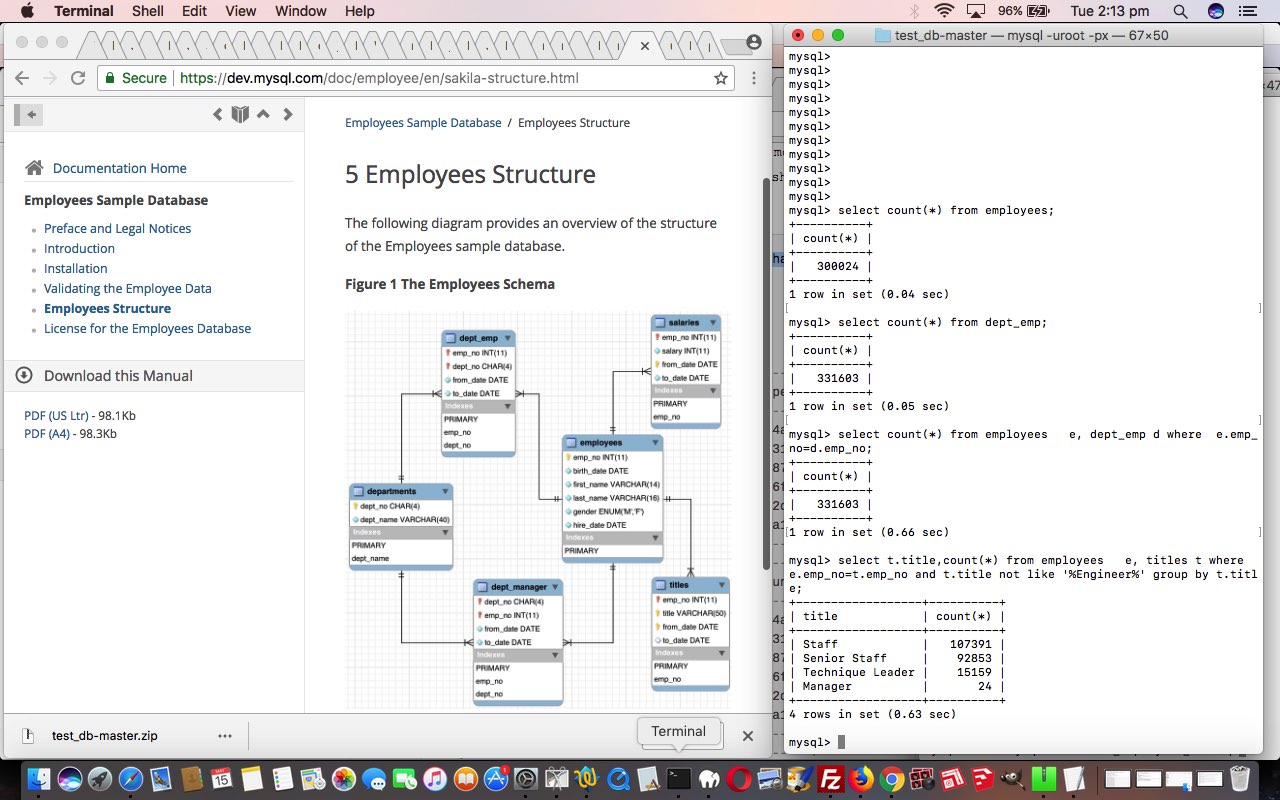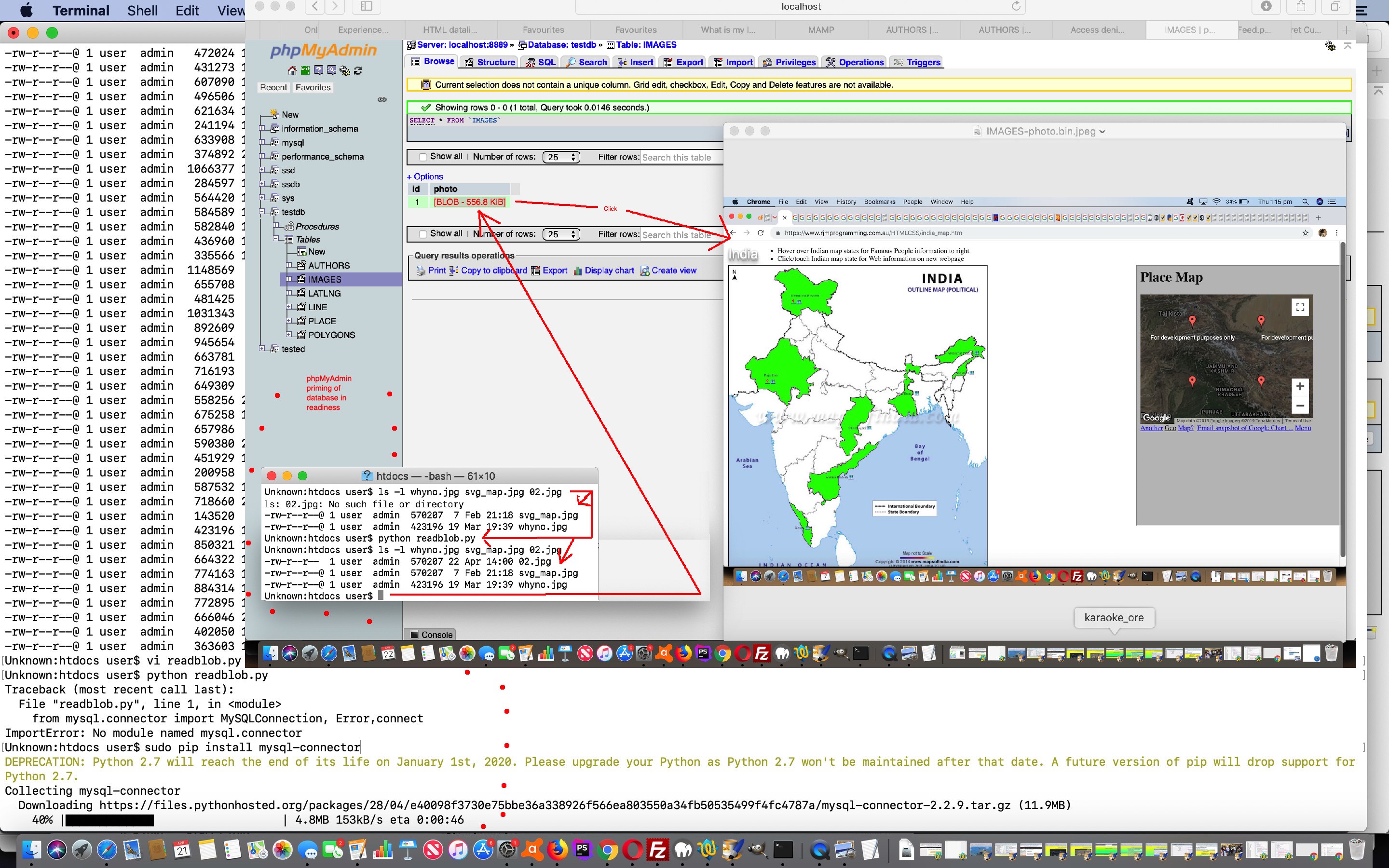Nov 01, 2017 Questions: How can I install the MySQLdb module for Python using pip? Answers: It’s easy to do, but hard to remember the correct spelling: pip install mysqlclient If you need 1.2.x versions (legacy Python only), use pip install MySQL-python Note: Some dependencies might have to be in place when running the above command. Oct 17, 2009 On my Mac running Mac OS X 10.5.8, I have the latest XCode tools and Python 2.5 installed. I installed MySQL 5.1 from the package version. I also got the MySQL-python-1.2.3c1.tar.gz which Mac unzipped in the downloads folder. To get installation instructions I read the following blog entry: MySQL, Python and MacOS X 10.6 (Snow Leopard). Sudo apt-get install python-pip python-dev libmysqlclient-dev Fedora 24: sudo dnf install python python-devel mysql-devel redhat-rpm-config gcc Mac OS brew install mysql-connector-c if that fails, try. Brew install mysql.
(Sponsors) Get started learning Python with DataCamp's free Intro to Python tutorial. Learn Data Science by completing interactive coding challenges and watching videos by expert instructors. Start Now!
Updated on Jan 07, 2020
Python Mysqldb Tutorial
MySQLdb is an api for accessing MySQL database using python. It is built on top of MySQL C API.
MySQLdb don't yet have support for python 3, it supports only python 2.4 - 2.7 . As a result you need to use python 2 for this tutorial. We will be using python 2.7.9, which you can download from here.
Installing MySQLdb #
A binary installation is available for Mac OS, and the process of installing MySQL on Mac OS is also very well documented. So just head over to MySQL.com, where you will find the binary installation, together with extensive installation, and usage documentation. To connect to MySQL from Python use MySQL for Python (MySQLdb).
Before installing you must first check whether MySQLdb is already installed on your system. To test open command prompt or terminal, then start python shell and type the following code
If it throws ImportError like this:
then you need to install MySQLdb. Otherwise, you have MySQLdb installed.
If you are on windows download the MySQLdb from here and install it.
In the next post we will discuss how to connect to the access database.
Other Tutorials (Sponsors)

This site generously supported by DataCamp. DataCamp offers online interactive Python Tutorials for Data Science. Join over a million other learners and get started learning Python for data science today!
Please enable JavaScript to view the comments powered by Disqus.- Python 3 Basic Tutorial
- Python 3 Advanced Tutorial
- Python 3 Useful Resources
- Selected Reading
The Python standard for database interfaces is the Python DB-API. Most Python database interfaces adhere to this standard.
You can choose the right database for your application. Python Database API supports a wide range of database servers such as −
- GadFly
- mSQL
- MySQL
- PostgreSQL
- Microsoft SQL Server 2000
- Informix
- Interbase
- Oracle
- Sybase
- SQLite
Here is the list of available Python database interfaces − Python Database Interfaces and APIs. You must download a separate DB API module for each database you need to access. For example, if you need to access an Oracle database as well as a MySQL database, you must download both the Oracle and the MySQL database modules.
The DB API provides a minimal standard for working with databases using Python structures and syntax wherever possible. This API includes the following −
- Importing the API module.
- Acquiring a connection with the database.
- Issuing SQL statements and stored procedures.
- Closing the connection
Python has an in-built support for SQLite. In this section, we would learn all the concepts using MySQL. MySQLdb module, a popular interface with MySQL is not compatible with Python 3. Instead, we shall use PyMySQL module.
What is PyMySQL ?
PyMySQL is an interface for connecting to a MySQL database server from Python. It implements the Python Database API v2.0 and contains a pure-Python MySQL client library. The goal of PyMySQL is to be a drop-in replacement for MySQLdb.
How do I Install PyMySQL?
Before proceeding further, you make sure you have PyMySQL installed on your machine. Just type the following in your Python script and execute it −
If it produces the following result, then it means MySQLdb module is not installed −
The last stable release is available on PyPI and can be installed with pip −
Alternatively (e.g. if pip is not available), a tarball can be downloaded from GitHub and installed with Setuptools as follows −
Note − Make sure you have root privilege to install the above module.
Database Connection
Before connecting to a MySQL database, make sure of the following points −
You have created a database TESTDB.
You have created a table EMPLOYEE in TESTDB.
This table has fields FIRST_NAME, LAST_NAME, AGE, SEX and INCOME.
User ID 'testuser' and password 'test123' are set to access TESTDB.
Python module PyMySQL is installed properly on your machine.
You have gone through MySQL tutorial to understand MySQL Basics.
Example
Python Mysqldb For Mac Installer
Following is an example of connecting with MySQL database 'TESTDB' −
While running this script, it produces the following result.
If a connection is established with the datasource, then a Connection Object is returned and saved into db for further use, otherwise db is set to None. Next, db object is used to create a cursor object, which in turn is used to execute SQL queries. Finally, before coming out, it ensures that the database connection is closed and resources are released.
Creating Database Table
Once a database connection is established, we are ready to create tables or records into the database tables using execute method of the created cursor.
Example
Let us create a Database table EMPLOYEE −
INSERT Operation
The INSERT Operation is required when you want to create your records into a database table.
Example
The following example, executes SQL INSERT statement to create a record in the EMPLOYEE table −
The above example can be written as follows to create SQL queries dynamically −
Example
The following code segment is another form of execution where you can pass parameters directly −
READ Operation
READ Operation on any database means to fetch some useful information from the database.
Once the database connection is established, you are ready to make a query into this database. You can use either fetchone() method to fetch a single record or fetchall() method to fetch multiple values from a database table.
fetchone() − It fetches the next row of a query result set. A result set is an object that is returned when a cursor object is used to query a table.
fetchall() − It fetches all the rows in a result set. If some rows have already been extracted from the result set, then it retrievesthe remaining rows from the result set.
rowcount − This is a read-only attribute and returns the number of rows that were affected by an execute() method.
Example
The following procedure queries all the records from EMPLOYEE table having salary more than 1000 −
Output
This will produce the following result −
Update Operation
UPDATE Operation on any database means to update one or more records, which are already available in the database.
The following procedure updates all the records having SEX as 'M'. Here, we increase the AGE of all the males by one year.
Example
DELETE Operation
DELETE operation is required when you want to delete some records from your database. Following is the procedure to delete all the records from EMPLOYEE where AGE is more than 20 −
Example
Performing Transactions
Transactions are a mechanism that ensures data consistency. Transactions have the following four properties −
Atomicity − Either a transaction completes or nothing happens at all.
Consistency − A transaction must start in a consistent state and leave the system in a consistent state.
Isolation − Intermediate results of a transaction are not visible outside the current transaction.
Durability − Once a transaction was committed, the effects are persistent, even after a system failure.

The Python DB API 2.0 provides two methods to either commit or rollback a transaction.

Example
You already know how to implement transactions. Here is a similar example −
COMMIT Operation
Commit is an operation, which gives a green signal to the database to finalize the changes, and after this operation, no change can be reverted back.
Here is a simple example to call the commit method.
ROLLBACK Operation
If you are not satisfied with one or more of the changes and you want to revert back those changes completely, then use the rollback() method.
Here is a simple example to call the rollback() method.
Disconnecting Database
To disconnect the Database connection, use the close() method.
If the connection to a database is closed by the user with the close() method, any outstanding transactions are rolled back by the DB. However, instead of depending on any of the DB lower level implementation details, your application would be better off calling commit or rollback explicitly.
Handling Errors
There are many sources of errors. A few examples are a syntax error in an executed SQL statement, a connection failure, or calling the fetch method for an already canceled or finished statement handle.
Python-mysqldb Mac
The DB API defines a number of errors that must exist in each database module. The following table lists these exceptions.
| Sr.No. | Exception & Description |
|---|---|
| 1 | Warning Used for non-fatal issues. Must subclass StandardError. |
| 2 | Error Base class for errors. Must subclass StandardError. |
| 3 | InterfaceError Used for errors in the database module, not the database itself. Must subclass Error. |
| 4 | DatabaseError Used for errors in the database. Must subclass Error. |
| 5 | DataError Subclass of DatabaseError that refers to errors in the data. |
| 6 | OperationalError Subclass of DatabaseError that refers to errors such as the loss of a connection to the database. These errors are generally outside of the control of the Python scripter. |
| 7 | IntegrityError Subclass of DatabaseError for situations that would damage the relational integrity, such as uniqueness constraints or foreign keys. |
| 8 | InternalError Subclass of DatabaseError that refers to errors internal to the database module, such as a cursor no longer being active. |
| 9 | ProgrammingError Subclass of DatabaseError that refers to errors such as a bad table name and other things that can safely be blamed on you. |
| 10 | NotSupportedError Subclass of DatabaseError that refers to trying to call unsupported functionality. |
Python Mysqldb For Mac Download
Your Python scripts should handle these errors, but before using any of the above exceptions, make sure your MySQLdb has support for that exception. You can get more information about them by reading the DB API 2.0 specification.
